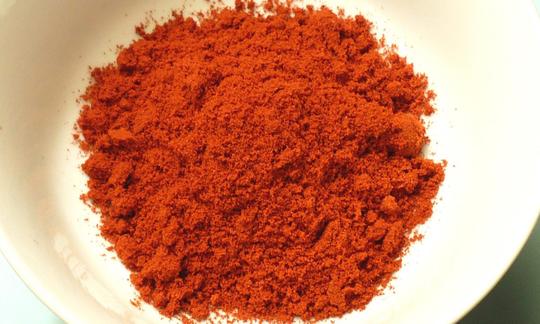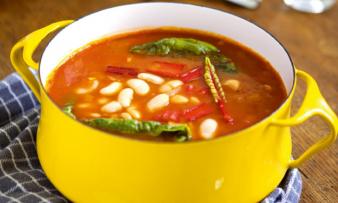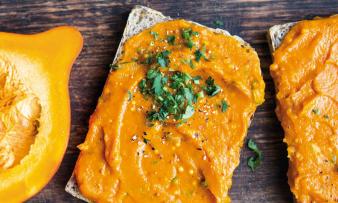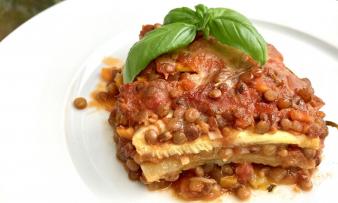Table of contents
Pimentón de la Vera ( smoked paprika powder, also Paprika de la Vera) is a Spanish paprika powder that is used in many dishes with its spicy, smoky note. Before grinding, the peppers ( organic) are dried in the smoke of oak wood. We could not obtain any information on a raw food variant ( raw) (as of May 2021).
Using Pimentón de la Vera in the kitchen:
The smoked paprika powder Pimentón de la Vera has an intense aroma, a bittersweet note and a noble smoky taste. The paprika powder is an important ingredient in many recipes, especially in Spanish cuisine. The smoked powder is indispensable for Spanish chorizo or paella.
Pimentón de la Vera tastes particularly delicious and spicy in dishes with tomatoes, potatoes and pulses. But smoked paprika powder also works well in dips, barbecue marinades or spreads. Recipes with Pimentón de la Vera: Whether in a vegetarian burger, in hearty soups (eg gazpacho), for tapas, omelettes or with fish, Pimentón de la Vera can be used in many different ways in the kitchen. If you want to add a certain spiciness to (vegan) dishes, cayenne pepper and chili powder are suitable additions.
Since Pimentón de la Vera (smoked paprika powder) has an intense smoky aroma, it is better to use it sparingly at first and add more seasoning if you want a stronger taste. Guideline: A dish for 4 people usually requires ½ teaspoon of paprika powder. Like all paprika powders, Pimentón de la Vera can burn easily and release bitter substances. Therefore, you should proceed with caution: It is best to fry the smoked powder at a low heat, add it at the end of the cooking time or alternatively stir it into liquids (e.g. soups). If you do not heat it, it tastes less intense: This makes the red powder ideal for garnishing.
Make your own Paprika de la Vera: Making the powder yourself is quite time-consuming, as the peppers have to be dried in smoke for several days before they can be ground. You can find information on making regular paprika powder under "Making paprika powder" for the ingredient sweet paprika powder.
Vegan recipe for cauliflower wings with paprika powder:
Ingredients (for 2 people): For the cauliflower: 1 head of cauliflower (organic), 150 ml water, 90 g wheat flour (wholegrain, organic), 1 tbsp cornstarch, 2 tsp garlic granules, 1 tsp paprika powder (sweet, organic), 1 pinch of salt, 1 pinchof black pepper. For the BBQ sauce: 120 ml water, 4 tbsp tomato paste (organic), 2 tbsp brown sugar, 1 tbsp chili oil, 2 tsp chili flakes, 1 tsp Pimentón de la Vera (smoked paprika powder, organic), a little salt and pepper to taste.
Preparation: First, cut the raw cauliflower into florets and wash them thoroughly. To make the dough layer, mix the flour with the water and spices and turn the cauliflower florets in it. Drain off the excess dough and place the cauliflower wings on a prepared baking tray. Bake the florets in the oven at 200 °C for 20-25 minutes. In the meantime, prepare the vegan BBQ sauce. To do this, put all the ingredients in a pot, simmer for a few minutes over low heat and allow to thicken. As soon as the vegan cauliflower wings are baked, you can take them out of the oven. Put the individual florets in the prepared BBQ sauce and turn them until they are completely covered with the sauce. Now put the cauliflower florets in the oven for another 10-15 minutes until they are crispy on the outside. You can serve the spicy cauliflower wings with a fresh salad and a vegan herb dip. A good side dish is whole grain rice (organic), which is best prepared at the beginning as it takes 30-40 minutes.
Vegan recipes with Pimentón de la Vera (smoked paprika powder) can be found under the note: " Recipes that have the most of this ingredient ".
| Not only vegans or vegetarians should read this: Vegans often eat unhealthily. Avoidable nutritional errors. |
Shopping - where to buy smoked paprika powder?
Where can you get smoked paprika powder? Pimentón de la Vera (smoked paprika powder) is available in supermarkets such as Coop, Interspar and Rewe. Major retailers such as Migros, Denner, Volg, Aldi, Lidl, Edeka and Hofer do not currently stock the Spanish paprika powder. The spice is also not currently available in the organic supermarkets Denn's Biomarkt and Alnatura (as of May 2021). Pimentón de la Vera or Paprika de la Vera is readily available in specialty stores or online. On the internet you can find the powder (as Pimentón, Pimenton or smoked paprika) in three different degrees of spiciness: dulce (mild), agridulce (medium hot) and picante (hot).
Is there "raw" Pimentón de la Vera? Due to the drying and smoking process and the sometimes very limited information available from distributors, it was not possible to determine whether this paprika powder is available as a raw food. In general, the term "raw food" (raw, raw food quality) is not subject to any control and is associated with a great deal of trust in the producers. Therefore, to be on the safe side, it is assumed that products without a raw food declaration are not raw foods. Even if they are, it is worth asking if you are unsure (see sweet paprika powder).
Storage of Pimentón de la Vera:
Always store spices such as Pimentón de la Vera in a dry, cool and airtight place, protected from light, so that the aromas are preserved for as long as possible. Unopened and hermetically sealed, the smoked paprika powder can be kept for up to 3 years; once opened, it should be used within 6 months. As the essential oils responsible for the aroma evaporate over time, the smell provides information about whether the smoky paprika powder still has a flavoring effect. 1 If stored incorrectly (e.g. in translucent glass containers), red paprika powder can turn yellowish-brown and lose its essential oils.
Ingredients - Nutritional values - Calories:
100 g of Pimentón de la Vera (smoked paprika powder) contains 304 kcal. Over half of the fine powder consists of carbohydrates (55 g/100g), of which 5.1 g are sugar and 22 g are fiber. Smoked paprika powder also contains 15 g of protein and 13 g of fat per 100 g. The high fiber content is comparable to ground allspice (21.6 g/100g) and ground turmeric (22.7 g/100g). Pimentón de la Vera contains many vitamins, minerals, essential oils and fiber. Please note, however, that you should only consume spices in small quantities.
The complete ingredients of Pimentón de la Vera (smoked paprika powder), the coverage of the daily requirement and comparison values with other ingredients can be found in our nutrient tables. In the article Nutrients explained you will get a detailed insight into the topic.
Health aspects - effects:
Pimentón de la Vera or Paprika de la Vera consists of smoked dried peppers and has a high amount of vitamin A, 17 which has been proven to play an important role in the vision process. 2
Smoked paprika powder (smoked paprika powder) is said to have an antioxidant effect, according to studies by researchers at the Universities of Extremadura and Valencia. 3,4 The red color of the powder is mainly due to the carotenoids contained in paprika, e.g. the red coloring capsanthin, which is also approved in the EU as a food coloring (E160c). The carotenoids act as antioxidants in the body and prevent oxidative stress by catching free radicals. Beta-carotene, which the body converts into vitamin A, and lycopene (a carotenoid that has a high antioxidant power) can also be found in paprika powder. 5
The secondary plant substance capsaicin contained in peppers is responsible for the spiciness of smoked paprika powder. In small quantities, capsaicin can have an anti-inflammatory, appetite-stimulating, circulation-enhancing and digestive effect. Too high quantities can irritate the skin and stomach lining. 6
Paprika powder also contains large amounts of essential oils and fiber. Fiber also stimulates digestion and counteracts constipation. 7
Dangers - Intolerances - Side effects:
Anyone who suffers from a cross allergy or has a rare allergy to nightshade plants (including potatoes, eggplants, tomatoes, cape gooseberries, tobacco, chili, sweet peppers, etc.) should avoid consuming paprika powder.
If you have an allergy to nightshades, you may experience reactions such as hives and swelling in the face, mouth and throat. Food intolerances, which should not be confused with allergies, can cause bloating and cramps. 8
The capsaicin contained in Pimentón de la Vera can trigger not only allergic skin reactions but also cross-allergies to tree pollen (e.g. birch, alder, hazel), but cross-reactions to mugwort pollen are also possible. 8 Cross-allergies are usually milder than main allergies. 9
Use as a medicinal product (smoked paprika powder):
In medicine, the hot capsaicin is primarily used. Internally, the alkaloid has a digestive effect, and externally, in the form of plasters and ointments, it helps against rheumatism and muscle pain. 10
There are ongoing studies on other uses of capsaicin for medical applications, such as the treatment of allergic rhinitis (allergic inflammation of the nasal mucosa) or blood sugar regulation through capsaicin supplements. With regard to rhinitis, a review by the Cochrane Library concludes that there is no therapeutic effect of capsaicin on the symptoms of allergic rhinitis. 11 Another review on capsaicin supplements concludes that this measure has neither an acute or chronic beneficial nor a detrimental effect on blood sugar and insulin levels. 12
Occurrence - Origin - Ecology:
The pepper plant ( Capsicum annuum) originally comes from Central and South America. Columbus brought it to Spain in the 16th century. It is believed that Monks in the Hieronymite Monastery of Yuste, located in Guadalupe in Extremadura, were the first to start growing peppers in their monastery gardens and using them to season their dishes. Emperor Charles V (after he resigned from all his offices, including the Spanish throne, in 1556 and chose the monastery of San Jerónimo de Yuste as his final residence) is also said to have been enthusiastic about the pimentón that the monks produced in their monastery. The pepper spread throughout Europe through traveling traders. Spanish and Portuguese traders eventually brought the fruit to Africa, India and Asia. 13
From the middle of the 17th century, the paprika began to be grown more and the paprika powder Pimentón de la Vera was produced for the world market. Today it is one of the main sources of income for the region and has enjoyed a protected designation of origin (Denominación de Origen 18) since 2007. Due to the protected designation of origin, every product used to make Pimentón de la Vera must come from the "La Vera" region, Extremadura, in Spain. Pimentón de la Vera consists of the deep red fruits of the Jaranda, Jariza and Jeromín varieties, as well as the Bola variety. The protected designation of origin covers the municipalities of the natural landscapes of La Vera, Campo Arañuelo, Valle del Ambroz and Valle del Alagón. Only if all processing steps (cultivation, drying and processing) take place within the geographical area of origin can the smoked paprika powder be called Pimentón de la Vera. 14
Cultivation - Harvest:
The peppers used to make Pimentón de la Vera (smoked paprika powder) grow in the Valley de la Vera in Extremadura in southwest Spain. Over the centuries, the plants have adapted completely to the climatic conditions of the La Vera region. The peppers thrive in the microclimate between the peaks of the Sierra de Gredos and the impressive gorges of the Tiétar River in the La Vera Valley. Summers there are hot and dry, and winters are mild. Two types of pepper have been cultivated to this day. One is Bola, a round, sweet pepper variety, and the other is Ocal, an elongated fruit that comes in varying degrees of spiciness. At the beginning of the 1990s, three varieties of Ocal peppers were bred for cultivation. Jaranda is sweet, Jariza is more spicy, and the Jeromín variation is hot in taste. 15
At the beginning of March, the sowing of the seeds in greenhouses begins. In May, farmers plant the small seedlings on extensive terraced fields. They need plenty of sunshine and enough water to thrive. The sun-ripened peppers can be harvested in October. 15
Ecological aspects:
Peppers and pepper products are often heavily contaminated with pesticides. Imported goods from Thailand and Vietnam are the most contaminated, but Turkish, Spanish and Moroccan peppers and pepper products also often contain high levels of pesticide residues. It is worth choosing organic peppers, as the use of chemical additives and pesticides is prohibited in organic farming. 16
Industrial production of Pimentón de la Vera:
As the pepper harvest (end of September and October) coincides with the autumn rains, drying in the sun is not possible. People therefore began drying the peppers over a fire and grinding them in stone mills to make the spice Pimentón de la Vera. Today, special smokehouses or drying rooms or drying floors are used for production, in which the fruit is spread out on a grate and gently dried in the smoke. Oak wood (the wood of the holm oak or pedunculate oak 14) is used for smoking, as it burns for a long time and gives the smoked food a rustic taste. 13 To ensure that the pepper pods dry evenly, they must be turned from time to time. The peppers are completely dried as soon as the moisture content is below 15%, which is the case after about 15 days. 15
The smoked paprika is then processed into a fine, red powder. To do this, the fruit is first broken up by mechanical hammering and the stems are removed. Next, a sorting machine removes the seeds from the peppers. Before smoked paprika can be finely ground, the pods must be chopped again and everything sieved. Stone mills then grind the pieces of paprika in 2-5 grinding cycles to produce fine Pimentón de la Vera. 15 Too much heat must not be generated during grinding, otherwise valuable nutrients can be lost. The finished smoked paprika powder is then poured into airtight tin cans, as these retain the smoky aroma of the powder well.
General information:
What is Paprika de la Vera? / What is Pimenton de la Vera? Pimentón de la Vera is a fine, red paprika powder that is produced exclusively in the "La Vera" region by grinding smoked peppers of the Capsicum annuum species. Pimentón de la Vera (smoked paprika powder) is available in three levels of spiciness, which are achieved by using different types of hot pepper. Pimentón dulce de la Vera is the mildest of the three spice powders. It is made primarily from the Bola variety and the sweet Jaranda pepper. Pimentón agridulce de la Vera has a slightly spicy taste and consists of the Jaranda and Jariza varieties. The hottest powder is Pimentón picante de la Vera. The hot Jeromín variety is used primarily for its production, but Jaranda and Jariza are also components of the powder. The number of Jeromín peppers used is crucial for the final spiciness of the smoked paprika powder. 16
Pepper ( Capsicum annuum) belongs to the nightshade family (Solanaceae) and is closely related to the potato and the tomato. The Bola variety is round and belongs to the Grossum group ( Capsicum annuum var. grossum), while Jaranda, Jariza and Jeromín are within the Longum group ( Capsicum annuum var. longum) classified. 17
Alternative names and spellings:
This smoked paprika powder is also known as Paprika de la Vera. The name Pimentón de la Vera is a protected term, so the English name is similar to the German one. Smoked paprika powder is known in English as smoked paprika or smoked paprika powder.
The Spanish term pimentón means something like paprika (dried and ground as a spice powder), so the whole term means "paprika from la Vera". Many searches use combinations such as pimenton paprika or paprika pimenton or pimenton spice. Because of the typical smoky aroma, you can also find the search term "smoked paprika" or even "smoke aroma powder", but this is very unspecific.
Incorrect or incomplete spellings such as: Pimenton, Pimenton de la, Pimenton dulce de la vera, Pimenton agridulce de la vera, Paprika dela Vera, Paprika la Vera, Pimento de la Vera, Pimento dela Vera, Pimenton la Vera, Paprika Vera, de la Vera Paprika, Pimenton Vera, Pimento Paprika, Pimientón de la Vera etc. are often found on the Internet.
Keywords for use:
Smoked paprika powder is also used as a natural preservative. 13
Literature - Sources:
Bibliography - 18 Sources (Link to the evidence)
| 1. | Hechoenlavera.com Trucos para conservar las Especias de tu cocina durante más tiempo (= Tricks, um die Gewürze in Ihrer Küche länger haltbar zu machen). |
| 2. | Dawson MI. The importance of vitamin A in nutrition. Curr Pharm Des. Februar 2000;6(3):311–25. |
| 3. | Campillo J, Tormo MÁ, Gómez-Encinas J, Campillo C, Vinas J, Borrás C et al. Efecto antioxidante e hipolipemiante del pimentón ahumado en individuos sanos Antioxidant and hypolipidaemic effect of smoked paprika in healthy subjects. 2010. |
| 4. | Tormo MJ, Campillo J, Viña J et al. The mechanism of the antioxidant effect of smoked paprika from La Vera, Spain. 2013. |
| 5. | Daood H, Palotás G, Somogyi G et al.Carotenoid and antioxidant content of ground paprika from indoor-cultivated traditional varieties and new hybrids of spice red peppers. Food Research International. 1. November 2014;65:231–7. |
| 6. | Lu M, Chen C, Lan Y, Xiao J, Li R, Huang J et al. Capsaicin-the major bioactive ingredient of chili peppers: bio-efficacy and delivery systems. Food Funct. 30. April 2020;11(4):2848–60. |
| 7. | Roger JDP. Heilkräfte der Nahrung, Praxishandbuch. Advent-Verlag Zürich. 3. Auflage 2008. |
| 8. | Ernaehrung.de DEBInet Deutsches Ernährungsberatungs- & -informationsnetz. Nahrungsmittelallergien - Pollen. |
| 9. | Gesundu.de Nahrungsmittelallergie auf Nachtschattengewächse. |
| 10. | J.D.Pamplona Roger. Heilkräfte der Nahrung, Praxishandbuch. Advent-Verlag Zürich. 3. Auflage 2008. |
| 11. | Cheng J, Yang XN, Liu X, Zhang SP. Capsaicin for allergic rhinitis in adults. Cochrane ENT Group, Herausgeber. Cochrane Database of Systematic Reviews. 19. April 2006 |
| 12. | Foshati S, Moradi S, Tavassoly M, Rouhani MH. Short- and long-term effects of capsaicin supplementation on glycemic control: a systematic review and meta-analysis of controlled trials. Food Funct. 2021; 10.1039.D1FO00595B. |
| 13. | Pepperworld.com Pimentón de la Vera. |
| 14. | Eur-lex.europa.eu Amtsblatt der Europäischen Union. Verordnung (EWG) Nr. 2081/92 des Rates. Eintragungsantrag gemäss Artikel 5 und 17, Absatz 2. "Pimentón de la Vera". EG-Nr.: ES/PDO/005/0321/29.10.2003. November 2006. |
| 15. | Gourmet-magazin.de Kolumbus, Pimenton de la Vera und die Wiege der Paprika in Europa. |
| 16. | Pini U. Das Bio-Food-Handbuch. Ullmann: Hamburg, Potsdam. 2014. |
| 17. | Minguez-Mosquera MI, Hornero-Mendez D. Comparative Study of the Effect of Paprika Processing on the Carotenoids in Peppers (Capsicum annuum) of the Bola and Agridulce Varieties. Journal of Agricultural and Food Chemistry, Juli 1994; 42(7): 1555–1560. |
| 18. | Eur-lex.europa.eu Official Journal of the European Union. Commission Regulation (EC) No 982/2007. |









Comments